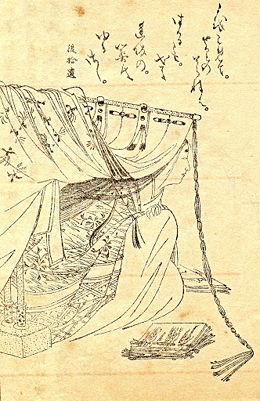Sei Shonagon
Sei Shōnagon (清少納言), (965-1010s?) was a Japanese author and a court lady who served the Empress Consort Teishi around the year 1000, known as the author of The Pillow Book (枕草子 makura no sōshi).
"Sei Shōnagon" 's actual given name is not known. It was the custom among aristocrats in those days to call a court lady (女房nyōbō) by a combined appellative taken from a) her clan name and b) some court office belonging either to her or some close relative. "Sei" (清) thus derives from the Kiyohara (清原) clan, while "Shōnagon" was a government post. It is unknown which of her relatives held the post of shōnagon. "Sei Shōnagon" 's actual name has been a topic of debate among scholars, who generally favor Kiyohara Nagiko (清原 諾子) as a likely possibility.
Little is known about her life except what is said in her writings. She was the daughter of Kiyohara no Motosuke, a scholar and famous waka poet. Her grandfather Kiyohara no Fukayabu was also a well-known waka poet. They were middle-ranking courtiers and had difficulties, since they were never granted a revenue-producing court office.
She married once, as far as we know, and had at least one daughter. When she began to serve the Empress Teishi, consort of Emperor Ichijō, she was supposedly divorced. She was fascinated by the young and beautiful Empress, a teenager when they met.
Shōnagon achieved fame through her work, The Pillow Book. The Pillow Book is a collection of lists, gossip, poetry, observations, complaints, and anything else she found of interest during her years in the court, during the middle Heian Period. In The Pillow Book Shōnagon reports the troubles Empress Teishi had after her father died and Shogun Fujiwara no Michinaga made one his of daughters another consort of the Emperor Ichijō. Because of the risk of fire, the Imperial family did not, at that time, live in the Grand Palace. Empress Teishi resided in a part of Chugushiki, the Bureau of Serving the Empress. Sei Shōnagon refers to the death of her patroness with refined lightheartedness and implies it was not difficult. To do otherwise would have been considered unstylish. Her writing depicts the court of the young Empress as full of an elegant and merry atmosphere.
There are no details about Shōnagon's life after the Empress died in childbirth in 1000, though The Pillow Book is thought to have been finished sometime between 1001 and 1010. One story has Sei Shonagon living out her twilight years in poverty, but this is probably a legend spread by those who disapproved of her alleged promiscuity.
She is also known for her rivalry with her contemporary Murasaki Shikibu, who wrote The Tale of Genji and served the Empress Shoshi, second consort of the Emperor Ichijō.
Notes
- The article incorporates text from OpenHistory.
External links
See also
de:Sei Shōnagon es:Sei Shonagon fr:Sei Shōnagon it:Sei Shōnagon hu:Szei Sónagon nl:Sei Shonagon ja:清少納言 ro:Sei Shonagon ru:Сэй Сёнагон fi:Sei Shōnagon tr:Sei Şonagon zh:清少納言
Credits
New World Encyclopedia writers and editors rewrote and completed the Wikipedia article in accordance with New World Encyclopedia standards. This article abides by terms of the Creative Commons CC-by-sa 3.0 License (CC-by-sa), which may be used and disseminated with proper attribution. Credit is due under the terms of this license that can reference both the New World Encyclopedia contributors and the selfless volunteer contributors of the Wikimedia Foundation. To cite this article click here for a list of acceptable citing formats.The history of earlier contributions by wikipedians is accessible to researchers here:
The history of this article since it was imported to New World Encyclopedia:
Note: Some restrictions may apply to use of individual images which are separately licensed.
